Motorola Atrix HD Preview: $99 Monster?
by Jason Inofuentes on July 14, 2012 8:19 AM EST- Posted in
- Smartphones
- Qualcomm
- Motorola
- Mobile
- Atrix HD
I was reminded yesterday of the Droid RAZR launch event. One of the RAZR product managers excitedly leapt at the opportunity to run me through some benchmarks on the demo device, a rare opportunity at these sorts of events. The results were, for the time, startling. Motorola took some time to optimize the browser in ways that set it head and shoulders above the competition in some benchmarks. The result was a Sunspider score that was fully half of its predecessor the Droid Bionic.
That's how I felt as I started to run the Motorola Atrix HD through its paces yesterday. The Atrix HD softens the hard edges of the RAZR design philosophy a touch, and to good effect. The white sample we received is understated and rather pretty, though I wonder if I wouldn't have preferred an all white back, rather than that expanse of Kevlar. And inside, Motorola has moved on from the OMAP 4 that won their hearts last year and adopted Qualcomm's Snapdragon S4. Yes, the MSM8960 scores another design win.
The results we're seeing, though, are a bit odd.
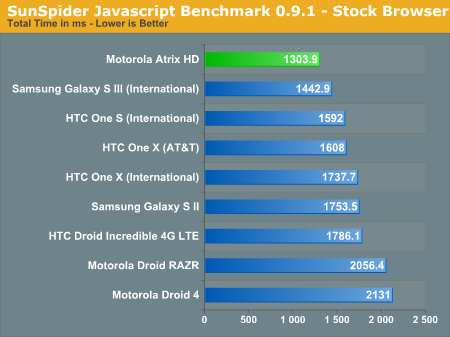
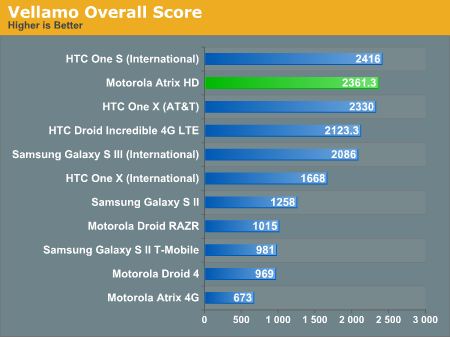
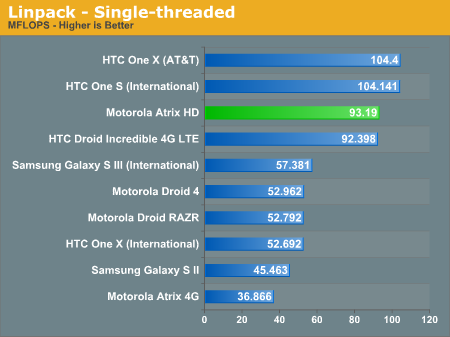
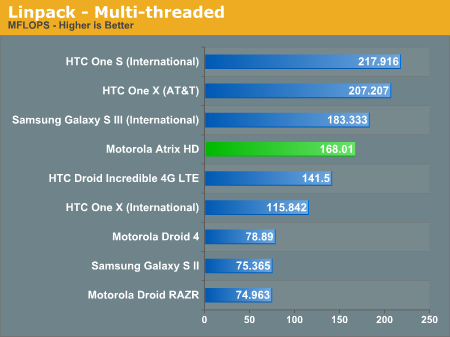
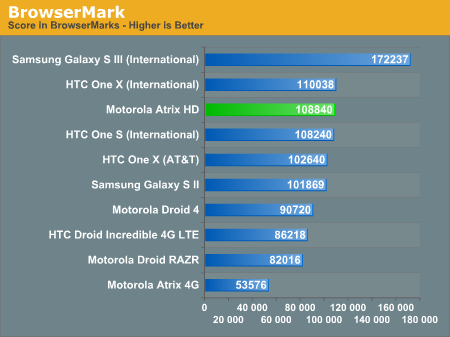

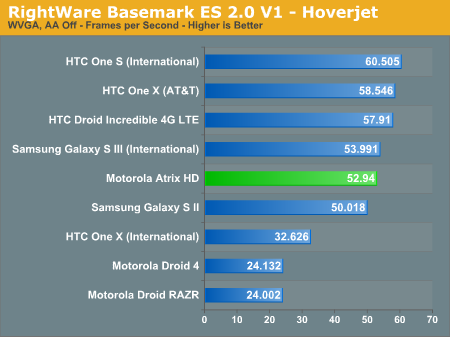

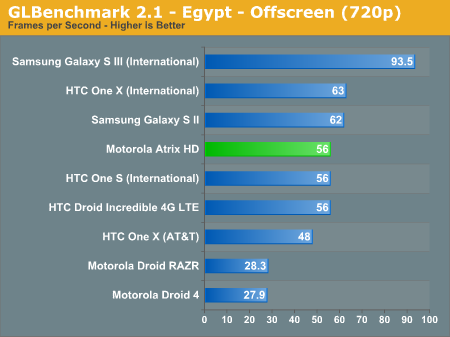
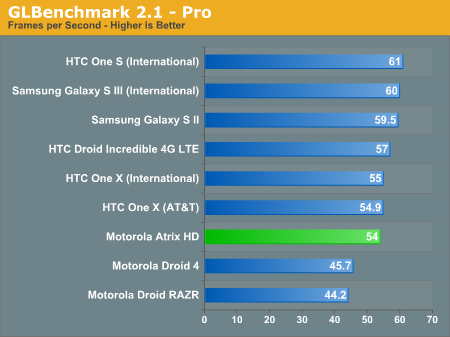
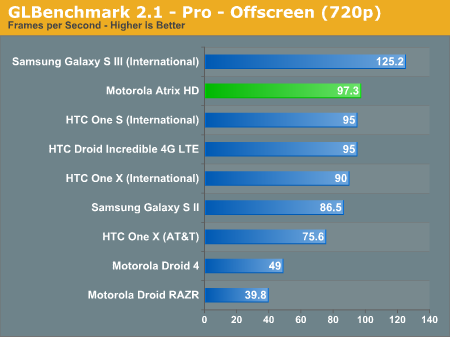
In the PC space there've been countless periods when we've had our suspicions that something sneaky was happening behind the scenes to generate extreme results in synthetic tests. I'm not suggesting Motorola's done something untoward; moreso than in the PC space, the AOSP code all OEMs start with leaves plenty of room for them to optimize to a particular hardware set-up. The numbers in the Sunspider score, though, exceed even Qualcomm's own Mobile Development Platform. Meanwhile, the rest of the benchmarks strike a much more conservative tone. We'll try and do some digging to figure out what's happening to generate these results leading up to the review. And we'll keep a close eye to see whether these synthetic results translate to real world performance.
For now, let's talk about Motorola's ICS skin, a huge departure from even the not-Blur variations we'd recently seen. All OEMs have their own clock/weather widget, and Motorola is no different, theirs is playful and features transparency effects that are oddly satisfying and allow the background to peek through. Folders work just like vanilla ICS, but home screens are laid out in a left to right fashion; and in a departure from other skins, only the main home screen is populated initially, the rest are fully absent. A swipe to the left reveals a prompt to add a blank page or one from a template. Motorola also tweaked some of the app icons, so a swipe up or down from atop the Phone icon brings up a Favorites pop-up, or Bookmarks for the Browser. This is actually a nifty way to add this functionality without cluttering your home screens with widgets, and I say kudos to Motorola for this one.
I haven't had a chance to characterize the display, but subjectively colors are bright and viewing angles are great. The body feels incredibly sturdy, as the RAZR before it, and the textured ring that goes around its edge has a pleasant tactile contrast to the smooth plastic of the rest of the frame. One note on that frame, around the display it is a glossy white plastic, but along the back it is a matte pearlescent white, not sure why the two-tone effect but it isn't jarring even when noticed. The larger screen means the excessive bezels of the RAZR are gone, while the Kevlar back continues to feel a bit out of place. We've only just begun our review process so we'll get back to it.


_575px.jpg)
_575px.jpg)
_thumb.jpg)
_thumb.jpg)
_thumb.jpg)
_thumb.jpg)
_thumb.jpg)
_thumb.jpg)








58 Comments
View All Comments
rarson - Sunday, July 15, 2012 - link
No MicroSD... no thanks.Just because Jelly Bean is released doesn't mean Ice Cream Sandwich is magically a turd overnight. I'm perfectly willing and able to wait for a port. I certainly agree with many of your points about the Nexus' upgrades and understand why many people would prefer it, but I'm not at all willing to spend $350 on a phone... ever. And while flashing roms can be a pain in the ass, I enjoy the experience of tinkering with my devices and improving their functionality beyond even what Google themselves give us.
dagamer34 - Sunday, July 15, 2012 - link
This would probably be a great phone, but the locked bootloader scares me away.antef - Monday, July 16, 2012 - link
Yes, ICS is a great OS, there wasn't even much that it needed improvement on, and I won't knock the custom ROM thing if it's something you enjoy. For me personally I just got tired of spending so much time on it and didn't see much need for any of CyanogenMod's extra features. I also got tired of the OEM's modifications, like Sense's tweaked multitasking and TouchWiz's ugly interface. So the Nexus gives me what I was looking for.You say you're not willing to spend $350 on a phone, but how much do you spend on cell service each month? $90-100 or more? The cost of the phone pales in comparison. I'm using the Nexus with $45/month Straight Talk prepaid. Compared to Verizon, AT&T, etc., that extra $150 spent on the phone is made up in about 3 months. After that it's actually cheaper than getting an expensive contract with a $200 phone.
MadMan007 - Monday, July 16, 2012 - link
There is a coverage difference between MVNO and carrier prepaid plans and contract plans.antef - Monday, July 16, 2012 - link
The only difference is no roaming. I'm using Straight Talk with AT&T which typically has more coverage than T-Mobile...I'll gladly give up T-Mobile roaming for $50/month savings. There is no justification for the criminal robbery that is Verizon and AT&T's contract prices.siberus - Monday, July 16, 2012 - link
To be fair locked bootloaders do suck but where there's a will there's a way. People have been able to get around the droids bootloaders for a while now the real question is will this device gain enough traction where the developer community will want to go through the effort to do it? Now im no programmer but i assume that since this device is using a different platform then previous moto phones the sideloading that people used for the droid 3/4/bionic/razer will need to be re-engineered to get passed the bootloader. Anyone know if any other recent qualcomm packing phones came with locked bootloaders that have been cracked/circumvented already?antef - Monday, July 16, 2012 - link
There are lots of phones out there with signed bootloaders that have never been fully cracked so that alternative kernels could be flashed. It's not the same thing nor as easy as getting it rooted. If you care about such things as the software on your phone, you simply shouldn't purchase from or support OEMs or carriers that lock it down like this.Zstream - Sunday, July 15, 2012 - link
I had no issues with my Atrix 4G. In fact it beats out my Nokia Lumia 900 and Iphone 4 in terms of battery life. It never "froze" on me or deemed slow. So, no I don't have any idea what you're talking about.KingKuba - Monday, July 16, 2012 - link
Never had a problem with my Atrix, fast, smooth, great battery life and that was on 2.2The only thing Galaxy Nexus has is updated software, nothing else. Everything else about it is not really worth talking about.
Software is overrated anyway, there's nothing really you can do on 4.0/4.1 that you can't do on 2.2/2.2, well except half the apps/games are still incompatible with ICS/JB.
jjj - Saturday, July 14, 2012 - link
If this is 99$ what the hell are they selling at 200$?Maybe they have a quad Krait ready soon.